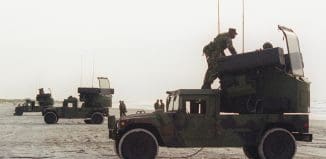Creative Anti-Chemical Weapon in Development
This post is also available in:  עברית (Hebrew)
עברית (Hebrew)
The Syrian civil war has brought chemical weapons back to the center stage in terms of international arsenals and defense methods. The U.S. military is investigating whether a protein in shark blood can help hunt for chemical and biological weapons and reveal them before they harm military personnel. Scientists from the U.S. Naval Research Laboratory (NRL) are using shark blood capabilities to create new ways to protect American warfighters. Funded by the Defense Threat Reduction Agency’s Joint Science and Technology Office, the research could lead to new detection and treatment tools.
Early detection is vital since it helps ensure early and correct treatment which can be the difference between life and death. According to foxnews.com, It can also be critical to ensure soldiers who are not yet exposed can be given protective medications in some instances. However, detection is difficult since these weapons can be far too small to be seen by the naked eye. Many of them are also odorless, presenting another problem for detection. These tiny threats can travel invisibly through the air and cause agonizing suffering or death.
Chemical weapons can cause horrible symptoms from blistering on the skin, suffocating sensations, coma and with some, death within minutes of exposure. Depending on the agent, biological warfare also causes a range of cruel symptoms from nausea and rash through to boils, haemorrhaging, paralysis and slow, painful death.
Shark antibodies could be integrated into sensors the military can use to identify and warn of a chemical or biological threat. They could also be used in devices to figure out if a warfighter has been exposed to a chemical or biological agent. Eventually, this component in shark blood could help to warn U.S. service members they’re under threat and at risk from biological and chemical weapons on the battlefield.
Although the use of chemical weapons has been banned since the Geneva Protocol of 1925, they continue to be developed and used. Syria, for example, is believed to have recently used mustard gas, sarin and chlorine. They could also unleash these threats U.S. forces, using artillery rockets, ballistic missiles and aircraft. The United Nations confirmed sarin gas was used in the Syrian capital Damascus in 2013. Under pressure that year, Syria agreed to destroy their chemical weapons in an agreement negotiated between Russia and the United States. However, in 2015, the UN Security Council believes a third chemical weapon attack occurred using chlorine gas. And this year, there was another suspected attack.
Many detection and treatment approaches tend to use mammal antibodies. Using shark antibodies instead provide advantages like the fact they are smaller and are also more stable. They could prove a lot more suitable for the field. This project is a great example of out of the box thinking that may improve the safety of US warfighters at a lower cost.





























